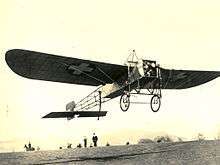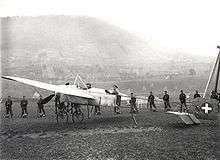Oskar Bider
| Oskar Bider | |
|---|---|
 | |
| Born |
12 July 1891 Langenbruck, Switzerland |
| Died |
7 July 1919 (aged 27) Dübendorf, Switzerland |
| Nationality | Swiss |
| Occupation | Pilot, farmer |
| Known for |
First flight over the Pyrenees, crossing of the Alps from Bern (Switzerland) to Milano (Italy) in both directions |


Oskar Bider (July 12, 1891 in Langenbruck – July 7, 1919 in Dübendorf) was a Swiss aviation pioneer.
Life
Oskar Bider grew up in Langenbruck (canton of Basel-Land) and graduated from the primary school to the district school in Waldenburg. He had no interest in his father's business as draper and preferred to become a farmer; he attended the Agricultural School in Langenthal and then worked on several farms. Having completed the primary military service (Rekrutenschule) in Switzerland in June 1911, he decided to emigrate to Argentina and worked in 1911/12 as a gaucho on the farm of a Swiss citizen living in Romang, Santa Fe.
Beginnings of Swiss Aviation
Driven by ambition and nostalgia, Oskar returned to Europe in 1912. On November 8 of that year he joined Blériot's aviation school in Pau, situated in the northern Pyrenees. After one month of training he earned an international pilot's licence on December 8, 1912 with Swiss pilot's licence number 32. He later bought a Blériot XI monoplane, and on January 24, 1913, pioneered in crossing the Pyrenees from Pau to Madrid.[1] In March 1913 he returned to Switzerland by train, welcomed at the border in Basel as a much-admired 'aviation hero'. On March 9 he flew the first airmail flight in Switzerland from Basel to Liestal. Later that year on May 13 he crossed the Alps from Bern to Sion, Switzerland for the first time.[2] [3]
Emile Taddéoli lost a wheel while taking off to fly from Bern to Biel/Bienne on June 3, 1913. Bider witnessed the incident and took off with the wheel to catch up with Taddéoli and warn him of the danger. Taddéoli acknowledged and landed without a problem in Biel/Bienne.[4]
Crossing the Alps
Bider's big goal was crossing the Alps from Bern to Milano which had been attempted three years earlier by fellow aviation pioneer Jorge Chávez. He prepared for this ambitious flight carefully and left nothing to chance. His first attempt did not happen as planned because a prior test flight showed that his airplane, with a 70-hp engine and full fuel tanks could not reach the required altitude in the thin mountain air. He decided to stop halfway in Domodossola to refuel and finish the flight. On July 13, 1913—one day after his 22nd birthday—he took off at 4 a.m. in Bern for Italy. The Jungfraujoch (Young maiden ridge) was the greatest obstacle for this flight and for over half an hour Bider struggled desperately before he finally reached the required altitude of 3,600 metres (11,800 ft) resulting in a new Swiss record. At 6:10 a.m. he passed the top of Jungfraujoch with about 100 metres (330 ft) of clearance. He stopped in Domodossola for fuel as planned and then finished his journey in Milano. He waited 13 days in Milano for good weather conditions and then flew back this time crossing Lukmanier Pass and Chrüzli Pass in northern Switzerland. He landed in Liestal to refuel and continued on to Basel and then to Bern. Bider thus became the first aviator to cross the Alps in both directions.
Other pioneering flights
Continuing his pioneering streak, on August 1, 1913, Bider completed the first night flight in Switzerland. On Christmas Day 1913, Bider set a new record flying from Paris to Bern in 4 hours and 20 minutes non-stop.
On June 21, 1919, Bider accomplished another great aviation performance in benefit of the civil aviation: he started with two passengers in St. Jakob, Basel, for a flight around Switzerland, landing successfully after seven and a half hours at the starting point.
Oskar Bider and Fritz Rihner started the Schweizerische Gesellschaft für Lufttourismus (Swiss Society for air tourism) in July 1919. Tour flights—using flying boats—were planned from sites at Zürichhorn, Geneva, Interlaken/Thun, Locarno, Lugano, Lucerne, Lausanne-Ouchy, Romanshorn and St. Moritz. Unfortunately, Oskar was killed in an accident before the ambitious project was realized.[5] On July 7, 1919, Bider, decided to celebrate his departure from duty in the Swiss Air Force on July 2. While flying a Nieuport 21 fighter—after a sleepless night—he attempted to demonstrate his flight knowledge and crashed fatally.
Honors

In Bern, a monument designed by Hermann Haller remembers Bider's aeronautical services.
Several streets were named after him: "Oskar Bider-Strasse" in Langenbruck, Dübendorf, Liestal and Zürich and "rue Oscar Bider" in Sion and Geneva.
Among other Swiss air pioneers, he is commemorated with a Swiss postage stamp issued in 1977.
The Bider-Hangar, called after Oskar, one of the hangars at Bern Airport, is listed as a heritage site in the November 2008 review draft of the Swiss Inventory of Cultural Property of National and Regional Significance.
References
- ↑ "Foreign Aviation News – Across the Pyrenees". Flight. 5 (5): 127. 1 Feb 1913. Retrieved 27 Aug 2013.
- ↑ "Flying over the Bernese Alps". Flight. 5 (229): 553. 17 May 1913. Retrieved 27 Aug 2013.
- ↑ "Crossing the Alps". International Service of the Swiss Broadcasting Corproation. 2013-07-13. Retrieved 2013-08-23.
- ↑ Emile Taddéoli on www.azimut270.ch respectively Otto Britschgi in AeroRevue 10/2007.
- ↑ Website Gang dur Alt-Zürich: Das Zürichhorn und die Zivilaviatik
External links
| Wikimedia Commons has media related to Oskar Bider. |
- Oskar Bider in German, French and Italian in the online Historical Dictionary of Switzerland.
- Oskar Bider on the official website of the canton of Basel-Land (German)
- Oskar Bider: flights 1913, death 1919, family